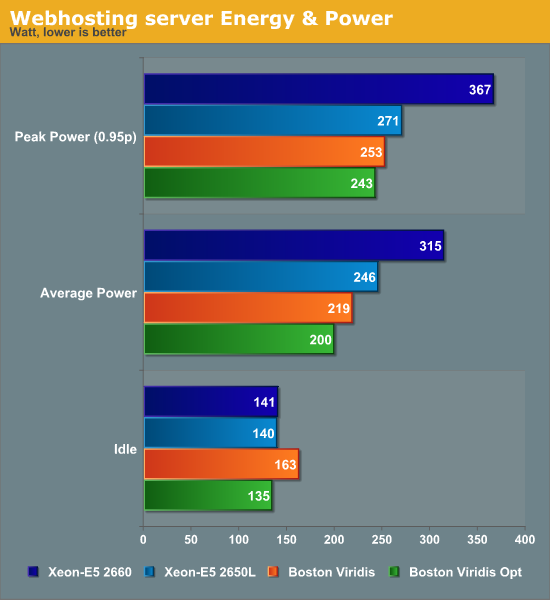Calxeda's ARM server tested
by Johan De Gelas on March 12, 2013 7:14 PM EST- Posted in
- IT Computing
- Arm
- Xeon
- Boston
- Calxeda
- server
- Enterprise CPUs
Energy and Power
And now, here's the million dollar question: did Boston and Calxeda succeed in building a server with a spectacular performance/watt ratio? Judge for yourself.

Calxeda really did it: each server needs about 8.3W (200W/24), measured at the wall. That is exactly what Calxeda promised: about 6W (at 1.4GHz) per server node (measured internally), up to 8.5W measured at the wall (again at 1.4GHz). That is nothing short of amazing if you consider the performance numbers.
In addition, the use of cpufreq and the downsizing of the server interconnects pays off here: we get 10% lower power on average and 18% lower power when idle. The optimizations are particularly important for the idle power use, where they spell the difference between using slightly more power and slightly less power than the Intel server.










99 Comments
View All Comments
tech4real - Thursday, March 14, 2013 - link
Calxeda quotes 6W for the whole SOC. We don't know how much is used for all these uncore stuff. It's possible A9 core only burns around 800mW. Still quite a gap to 1.25W.Wilco1 - Thursday, March 14, 2013 - link
Assuming the 800mW figure is accurate and the uncore power stays the same, then a node would go from 6W to 7.8W - ie. 30% more power for 100% more performance. Or they could voltage scale down to 1.5GHz and get 65% more performance for 5% more power. While a 28nm A15 uses more power in both scenarios, it is also much faster, so perf/Watt is significantly better.tech4real - Thursday, March 14, 2013 - link
1. I guess we have to wait to see if it's really 2X perf from a9 to a15 in real tests. I personally wouldn't bet on that just yet.2. mostly likely the uncore power will increase too. i don't think the larger memory bandwidth will come free.
Wilco1 - Thursday, March 14, 2013 - link
1. We already know A15 is 50-60% faster than A9 per clock (and often more, particularly floating point), so that gives ~2x gain from 1.4GHz to 1.8GHz.2. The uncore power will be scaling down with process while the higher bandwidth demand from A15 will increase DRAM power. Without detailed figures it's reasonable to assume these balance each other out.
tech4real - Thursday, March 14, 2013 - link
then let's wait to see anand benchmarks the future a15 system.also since the real microserver battle is between the future a15 system and 22nm atom system, I am eager to see how it plays out.
Th-z - Wednesday, March 13, 2013 - link
Very interesting article, thanks! This really piques another curiosity: how does latest IBM Power based server fair these days.Flunk - Wednesday, March 13, 2013 - link
It really doesn't sound like the price\performance is there. Also, lack of Windows support makes it useless for those of us who run ASP.NET websites (like the company I work for).It's still nice to see companies trying something different from the standard strategy. Maybe this is be better in a few generations and take the web server market by storm. If we see a Windows Server arm I could see considering it as an option.
skyroski - Wednesday, March 13, 2013 - link
I agree your testing suite's method is good and ok, so you were testing in consideration with hosting providers, fair enough.However on the topic of if you were serving a single site would a standard Xeon be better or ARM based ones? Which - is the case of consideration to FB/Twitter/Google/Baidu etc..., whom are as I have been led to believe by the media this past year, companies that ARM partners are trying to sell this piece of kit to. This test unfortunately cannot tell us.
A quick search on Google on performance impact of VMs yielded a thread in the VMware community forum by a vExpert/Moderator that mentioned expectation of 90% performance, and frankly, no matter how small you think the performance impact of a VM maybe, it is still using up CPU cycles to emulate hardware, that point will remain true no matter how efficient the hypervisor gets.
Secondly, coupled with the overhead of running 24 physical copies of the OS + Apache + DB on a box that would otherwise be running a single copy of the OS + Apache + DB is total overkill (on that topic)
It would be great if you can also test Xeon's req/sec if it ran a single instance so we can see it from a different perspective, as of now as I said, your test is skewered towards hosting providers whom might invest in Calxeda to provide VPS alternatives. But to them (and their client base), the benefit of a VPS is it's portability, which, 24 physical ARM nodes isn't going to provide, so I don't see them considering it as an alternative solution anyway.
skyroski - Wednesday, March 13, 2013 - link
I also want to ask if your Xeon test server's network adapter is capable of and was using Intel VT-c?JohanAnandtech - Thursday, March 14, 2013 - link
It was using VMDq/Netqueue (via VMXnet) but not SR-IOV/VT-c